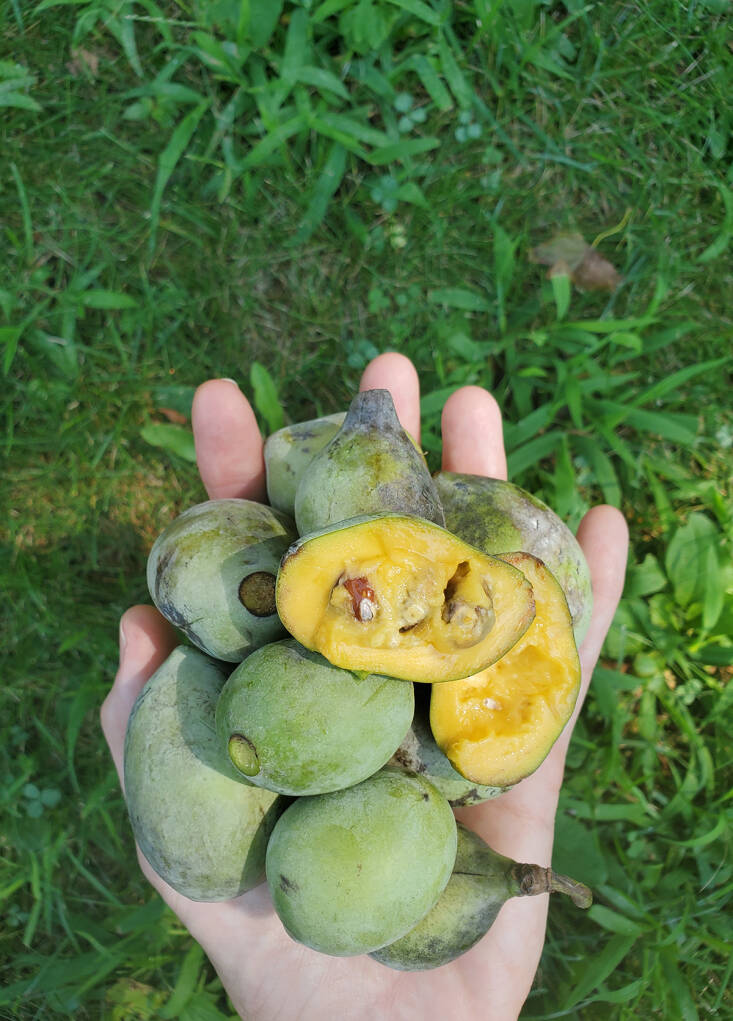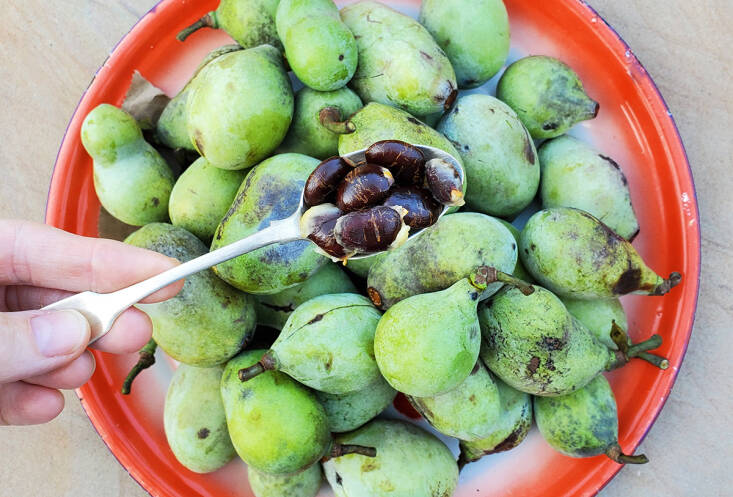As soon as late summer edges toward fall in New York, I begin to lick my pawpaw-loving lips. As this native North American fruit gains mainstream recognition it has become easier to source both the fresh fruit as well as pawpaw saplings. Despite the rising tide of awareness, many people are still unfamiliar with them and have yet to taste a fresh pawpaw. And if you have lusted after the perfumed fruit but have not met one, there are few things about these green-mango lookalikes you may not know.
Here are 15 of them.
Photography by Marie Viljoen.
1. “Pawpaw” actually refers to two completely different and unrelated fruit.

The pawpaw under discussion is the native North American fruit belonging to the genus Asimina. The cold-hardy common pawpaw is A. triloba, but there are over a dozen other species, with regional distributions that cleave to the eastern and Mid-Western parts of the United States, from southern Canada down to Florida.

In regions and countries with Commonwealth and British colonial histories (think Australia, England, India, South Africa, the West Indies, and more) the common name “pawpaw” refers to what anyone from the Americas calls papaya. Soft-skinned and subtropical, small or football-sized, that pawpaw, Carica papaya, has yellow to deep rose flesh and is filled in the center with little black, peppery seeds. It is available in many grocery stores, year-round.
2. For the Shawnee, September is the month of the pawpaw moon, ha’siminikiisfwa.

The botanical genus name Asimina is derived from the Shawnee word for pawpaw: ha’simini. For the Shawnee, September is the month of the pawpaw moon, ha’siminikiisfwa, according to Joel Barnes, Archives Director for the Shawnee Tribe (via a West Virginia Public Radio interview in a 2020).
Until the 19th century, before they were forcibly removed by the US government, the Shawnee’s ancestral lands were in pawpaw-rich Appalachia, including current southeast Ohio.

3. The fruit has inspired an annual three-day festival.

The three-day Ohio Pawpaw Festival in southeast Ohio in September is a celebration of everything pawpaw. There are pawpaw tastings, and dozens of pawpaw dishes to choose from. Chris Chmiel is one of the founders of the festival and the co-owner (with Michelle Gorman, his wife) of Integration Acres, which has sold the fresh fruit and frozen purée, and other native wild things to the public since 1996. (The first pawpaws I tasted were shipped from Ohio’s woodlands to my Brooklyn front door in 2016.)
4. The crew of the trans-continental Lewis and Clarke expedition were sustained by “poppaws.”

On 18 September, 1806, William Clark wrote, in the detailed journal that Thomas Jefferson dictated the expedition keep, that “…our party entirely out of provisions Subsisting on poppaws…the party appear perfectly contented and tell us that they can live very well on the pappaws [sic].”
There are many similar entries (reading the journal is equal parts recoil and wonder; but it is a compelling chronicle of plants encountered).
5. Pawpaws taste like a medley of ripe tropical and subtropical fruits. Or creme brûlée.

The aroma of pawpaws is strong—they will perfume a room. Their texture when ripe is creamy. Different cultivars vary in flavor: Some pawpaws taste like a kaleidoscope of passionfruit and pineapple, lychee, and mango. Many tasters mention banana; personally, I detect none, but perhaps it is the pawpaw’s soft consistency that inspires the comparison. Others taste like caramel, lightly scorched. Think crème brûlée, with tropical overtones. A fruit may taste intense, or mild. The little slippery sac around each large seed is slightly bitter, as is the flesh closest to the skin.
6. Pawpaws come in different shades.

7. Bruising isn’t bad.

Unless they are very close to ripe on the branch, pawpaws do not ripen well once picked (they are not like avocados). Visiting your local tree/s after a windstorm or heavy rain is a great way to find windfalls. Their skin may bruise or discolor, but this seldom means that the fruit itself is damaged. Rather, it’s a sign of ripeness.
8. Pawpaws contain many large, glossy seeds.


Pawpaws are close cousins of custard apple (cherimoya) and soursops. All these large-seeded, soft-fleshed, deeply aromatic fruit belong to the family Annonaceae. The pawpaw is the cold-hardiest among them.
9. Pawpaw seeds are a laxative.

There’s no reason why you would, but don’t chew up and swallow pawpaw seeds. Eating the skin has the same effect.
10. Some people may be allergic to pawpaws.

While the evidence is anecdotal, there is enough chatter in online forums to suggest that some people react badly to eating pawpaws. The result is dramatic diarrhea and, sometimes, nausea. Eat pawpaws in moderation (I cut myself off at three in one sitting. Is that moderate?). Also, some pawpaw purveyors, like Integration Acres, recommend against drying the pulp for use in fruit leather, since it can cause gastrointestinal distress. The reasons for this are not understood (yet).
11. Pawpaws contain toxins.

Some researchers posit that eating pawpaws regularly could be detrimental to the eater. The seeds and pulp of pawpaws contain acetogenins, including annonacin, which is toxic to cortical neurons. Could regular pawpaw ingestion cause neurotoxins to build up over time? A connection has been drawn between pawpaws and their cousins, custard apples, which are popular in the Caribbean, where clusters of Parkinson’s in Guadalupe have been documented, possibly linked to a diet where the custard apples feature regularly. (Annonacin was also thought to play a role in cancer-cell death. That published paper has since been retracted.)
12. The common pawpaw is cold-hardy.

The common pawpaw is hardy from USDA growing zones 5 through 8 (according to Cornell). It’s the tropical-tasting fruit many cool-climate gardeners can grow. Bradley Farms in New Paltz, New York (zone 5), brings pawpaws to greenmarkets in October. While pawpaws in the wild tend to grow in clonal colonies in the woods and on woodland edges, pawpaw trees will thrive in full sun as long as they have ample moisture in summer. They like hot, humid summers and cold winters.
13. For propagation, do not allow pawpaw seeds to dry out.

Sowing pawpaw seed is most successful when the seeds are planted before they dry out. Even three days of drying can reduce germination rates to 20%, according to the University of Kentucky. (If you can’t plant them at once, keep them in a baggy with potting soil until you can). Sowing them in fall (right after you eat them) allows them to cold-stratify naturally, outdoors.
14. Pawpaws transplant badly.

If you’re mosying around a pawpaw patch and are tempted to remove a sapling, think twice: Pawpaws have long taproots and respond poorly to being yanked out. Unless you have emerald-green thumbs, either grow them from seed or find a nursery that sells pawpaw trees. More and more do.
15. Pawpaw pulp freezes beautifully, with no loss of flavor.

It’s some trouble to scoop out all the seeds and purée the pulp in a food processor (make sure you have no seeds or skin), but once done it is easy to freeze pawpaw pulp in batches. It it is delicious in ice cream, but also cooked in cakes, cookies, breads, and savory dishes. Contrary to some online opinion, the flavor of pawpaw holds up very well to heat.
See also:
- Pawpaw: A Native Fruit that Tastes Like the Tropics
- Yuzu Season Is Here: Rejoice, Harvest, and Make Yubeshi
- A Unique Seasonal Treat: Spiced, Candied Crabapples









Have a Question or Comment About This Post?
Join the conversation